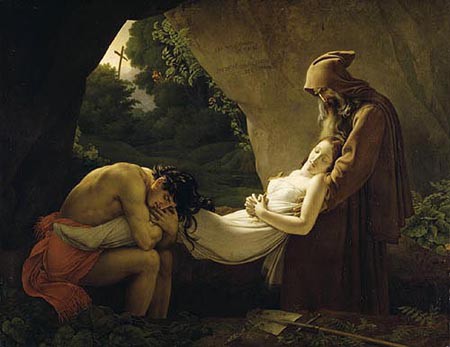A few months ago, while driving south on the 101 to visit my sister, I witnessed a scene that still haunts me. In the distance I saw in the middle of the highway what looked to be a rabbit running, except the rabbit wasn’t getting anywhere. As our car approached, the reason for the rabbit’s static situation became clear–the lower half of its body had been flattened by a passing vehicle while its upper half remained intact and struggling. My heart broke for this helpless creature; hope for survival was futile and I wished that its pain would be brief.
Reflecting on the tragic rabbit, my thoughts turn to one of the pillars of Buddhism, which states that “life is suffering.” I realize this English translation falls terribly short of the rich meaning enveloped in that statement, and I am not Buddhist, but I find universal truth in the teaching. Or, as Wesley tells Buttercup in The Princess Bride, “Life is pain, highness. Anyone who says differently is selling something.” Here I would like to claim that “art is suffering,” or “in art there is suffering.”
Nearly half my lifetime ago, I visited the Louvre in Paris and among many works there, “The Tomb of Atala” by Girodet touched me.
In this captured moment of intense grief, there is beauty and hope. The artist balances emotions of pain and passion with all the skills of his trade: a classical composition, contrast of light and dark, employment of Christian symbols, soft brush strokes and more. Like this painting, many faith traditions, including my own of Christianity, offer meaning and hope amid death and suffering.
Literature, performing and visual arts are laden with suffering and I submit that to some degree the theme is essential for a successful piece. A few years ago I read several novels in a row that ended with a tragic death and I questioned my choice of books. Then I reflected that many of the classics include death, at least at some point in the work; and if not death, some other tragedy. In fact, the very first grade level definition of plot teaches that a story must have a beginning, a middle (which is the “problem”) and an end (the “solution”). Thankfully, fine works of art become increasingly more nuanced and layered than this, but the basic definition usually stands. I recall concluding both “The Fault in Our Stars” and “The Kite Runner” through exhausted, cried-out eyes and those painful reads were cathartic. The challenges one faces through art, though not their own, have the power to deepen character and understanding. I am also an advocate for the arts that merely entertain and brighten, but art containing tragedy is healing through co-suffering.
This idea of co-suffering has been on my mind lately, prompted by a two-part podcast: https://player.fm/series/mormon-matters-1169768/339-mercy-and-the-atonement-part-1.
I was discussing the idea of “mourning with those that mourn” with my seven year old daughter. I explained that this means to feel sad with someone who is sad. She said, “That’s a dumb idea–it’s just spreading sadness.” My point to her was that it’s “sharing sadness” and paradoxically, the sadness is not just spread, but dissipated. Art has power, just like a dear friend, to diffuse pain by inviting us to share in the struggle. The arts invite us in, widen our scope and bind us to human experience.
In a mindfulness practice, I recently learned about a concept known as “negativity bias.” The short of it is that negative thoughts and experiences stick to us like Velcro, while the positive ones slip off like Teflon. Here is an explanation as to why: https://www.rickhanson.net/how-your-brain-makes-you-easily-intimidated/.
I have chronic pain that manifests itself in different ways and in varying degrees over time. The last few months have prompted some deep reflection and I’ve noticed that my attitude towards pain has matured over the last decade. Of course, my strongest human instinct is to just wish the pain away, but I can now more clearly see the good that laces hard times. I have learned a greater degree of patience, I treasure the gift of seeking help and answers (not just the help and answers themselves), and I have developed meaningful relationships through shared experience. One such relationship is with a physical therapist, with whom I was fortunate enough to work in two states. We recently shared a phone conversation that prompted much needed spiritual and physical healing (I nickname her the “metaphysical therapist).
So what stays with us from a particular work of art or a life experience? Is it the pain, the grief, the suffering, or is it the light, joy and beauty woven throughout? My submission is that it has to be both; awareness and gratitude must exist for the entirety or meaning is lost.

